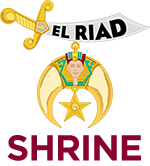Temple History
The major resemblance of Shriners International to any possible or near prototype existing in Middle Eastern Europe back in the sixth century is in its selection of names for its Temples; in its glamorous pageantry; in its colorful ceremonial and parade costumes and trappings, and its return to early history for the ritualistic lessons.
 Billy Florence and Dr. Walter Fleming, the co-founders of the Mystic Shrine of North America, were more than passing good showmen. Actor Billy Florence was reared to regard the world as a stage and the people as actors. Dr. Fleming could have earned a good livelihood as a juggler and magician. It was while on a trip to Europe that the great actor Florence was invited by a banker to attend a party given by an Arabian diplomat. The entertainment was something in the nature of an elaborately staged musical comedy; at the conclusion of which the guests became members of a secret society. Billy Florence realized immediately that here was a ritual that would be both impressive and amusing; something in which good fellowship would abound.
Billy Florence and Dr. Walter Fleming, the co-founders of the Mystic Shrine of North America, were more than passing good showmen. Actor Billy Florence was reared to regard the world as a stage and the people as actors. Dr. Fleming could have earned a good livelihood as a juggler and magician. It was while on a trip to Europe that the great actor Florence was invited by a banker to attend a party given by an Arabian diplomat. The entertainment was something in the nature of an elaborately staged musical comedy; at the conclusion of which the guests became members of a secret society. Billy Florence realized immediately that here was a ritual that would be both impressive and amusing; something in which good fellowship would abound.
One of the first decisions made was that the Shrine should be restricted to 32nd degree Scottish Rite Masons and Knights Templars. A meeting was called on September 26, 1872, in Masonic Hall, 115 East 13th Street, New York, for the purpose of formally organizing the first Shrine Temple in the United States. They gave the name of Mecca to this first temple. Three years later a second Shrine Temple to be called Damascus was established in Rochester, New York. The order remained quiet and inactive for a number of years. In the first report of membership which was not rendered until 1876 there were only 43 nobles, all but six of them in New York City.
Fleming called a fourth meeting of Mecca Temple to be held June 6, 1876, at the Masonic Temple in New York. It was at that meeting that the Imperial Council came into existence.
 Our headquarters are in Tampa, Florida, however, our 200 Temples are located throughout North and Central America, Germany and The Philippines. In addition, there is a vast network of Temples, Shrine Clubs and Oasises in North America, Central America, Europe and the Orient, all of which are under the jurisdiction of one or more of the Temples located in North America. The officers of the National Governing Body are called the Imperial Divan. Like the ritual, we have adopted Arabic names for these positions. The highest ranking officer is called the Imperial Potentate and his duties and authority are similar to the Chief Executive Officer of a large corporation. Each Temple elects representatives to the Imperial Council, which is the legislative body that makes our rules and elects the National officers.
Our headquarters are in Tampa, Florida, however, our 200 Temples are located throughout North and Central America, Germany and The Philippines. In addition, there is a vast network of Temples, Shrine Clubs and Oasises in North America, Central America, Europe and the Orient, all of which are under the jurisdiction of one or more of the Temples located in North America. The officers of the National Governing Body are called the Imperial Divan. Like the ritual, we have adopted Arabic names for these positions. The highest ranking officer is called the Imperial Potentate and his duties and authority are similar to the Chief Executive Officer of a large corporation. Each Temple elects representatives to the Imperial Council, which is the legislative body that makes our rules and elects the National officers.
Each Temple operates under a charter granted by the Imperial Council and must conform to the bylaws and rules established by that body. Reasonable autonomy has been given the individual Temples to carry on Temple business and social activities of their own choosing. Each Temple has its own Potentate and Divan. They are responsible for the government and operation of the Temple in manner similar to the Imperial Divan, all according to the laws of the Imperial Council.
 On December 26, 1887, a group of 13 men left Sioux Falls and traveled to Cedar Rapids, Iowa, where they were initiated into the Shrine by El Kahir Temple. It was on April 3, 1888, that dispensation was granted to El Riad Temple. On May 25, 1888, the first Ceremonial of the Nobles of the Mystic Shrine held in Dakota Territory was called to order in Sioux Falls by W.O. Stites, first Potentate of El Riad Temple. 33 men were taken in to El Riad Temple at this ceremonial.
On December 26, 1887, a group of 13 men left Sioux Falls and traveled to Cedar Rapids, Iowa, where they were initiated into the Shrine by El Kahir Temple. It was on April 3, 1888, that dispensation was granted to El Riad Temple. On May 25, 1888, the first Ceremonial of the Nobles of the Mystic Shrine held in Dakota Territory was called to order in Sioux Falls by W.O. Stites, first Potentate of El Riad Temple. 33 men were taken in to El Riad Temple at this ceremonial.


